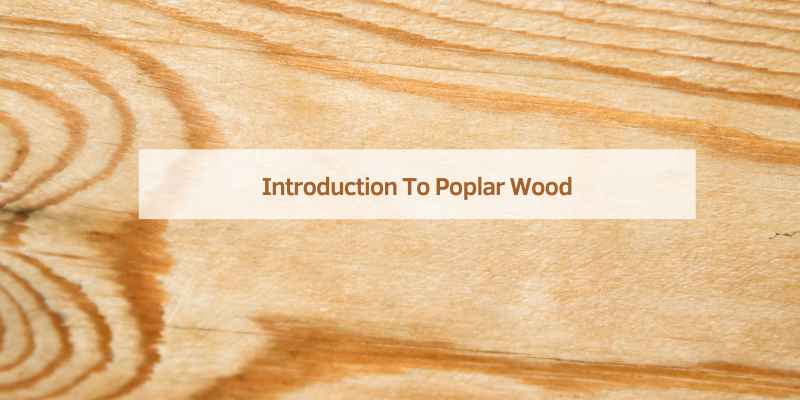Poplar is a hardwood, not a softwood. It is known for its versatility and affordability in woodworking projects.
Poplar trees grow quickly and are commonly used for furniture, cabinets, and millwork. The wood is easy to work with, making it a popular choice for both professional carpenters and DIY enthusiasts. Despite its classification as a hardwood, poplar is softer than other hardwoods like oak or maple.
Its light color and smooth texture make it ideal for staining or painting to achieve various looks. With its strength and cost-effectiveness, poplar continues to be a favored material in the woodworking industry.
Introduction To Poplar Wood
Poplar wood is a popular choice in woodworking due to its versatility and affordability. This fast-growing tree species is known for its light color and straight grain, making it a preferred option for a wide range of projects. In this section, we will delve into the botanical profile of poplar wood and explore its common uses in woodworking.
Poplar’s Botanical Profile
Poplar, belonging to the genus Populus, is a deciduous hardwood tree that is native to many parts of the Northern Hemisphere. The wood of the poplar tree is renowned for its fine, even texture and minimal color variation, making it an ideal material for various woodworking applications.
Common Uses In Woodworking
Poplar wood is commonly utilized in the construction of furniture, cabinets, and millwork due to its ease of machining and finishing. Additionally, its stable nature and resistance to warping make it a popular choice for interior moldings and trim work. The wood’s ability to take stains and paints well further contributes to its widespread use in the woodworking industry.

Hardwood Vs. Softwood: Core Differences
When it comes to understanding the differences between hardwood and softwood, it’s essential to delve into their botanical classification, characteristics, and properties. Let’s explore the core disparities between these two types of wood.
Botanical Classification
Hardwood comes from deciduous trees, which are trees that shed their leaves annually. These trees are classified as angiosperms, bearing seeds within an enclosure, such as fruits or nuts. Examples of hardwood trees include oak, maple, and cherry.
Softwood, on the other hand, is derived from coniferous trees, which typically have needles and cones. These trees belong to the gymnosperms category, with seeds that are not enclosed. Common softwood species encompass pine, cedar, and spruce.
Characteristics And Properties
Hardwood is renowned for its dense and robust nature, making it suitable for high-quality furniture, flooring, and construction. It tends to display intricate grain patterns and is often more resistant to wear and tear.
Softwood, in contrast, is generally lighter and less dense. It is commonly used in construction, outdoor furniture, and paper production due to its flexibility and ease of shaping.
The Misconceptions Around Poplar Wood
Poplar wood is often misunderstood, with many questioning if it’s a softwood or hardwood. Despite its classification as a hardwood, poplar is relatively soft and lightweight, making it ideal for various indoor projects and furniture. Its affordability and ease of use make it a popular choice for DIY enthusiasts and woodworkers alike.
Myths In Timber Terminology
Poplar wood is a popular material in woodworking, furniture making, and construction. However, there are some misconceptions surrounding this type of wood, particularly whether it is a softwood or hardwood. While some people may assume that poplar is a softwood due to its light weight and relatively low density, this is not entirely accurate. In fact, poplar wood has properties that place it somewhere between softwood and hardwood.
Common Confusions
One of the common confusions around poplar wood is whether it is a hardwood or softwood. As mentioned earlier, poplar wood can be classified as both hardwood and softwood. This is because it is a deciduous tree that belongs to the Salicaceae family, which also includes willow and aspen trees. While poplar wood is not as hard as oak or maple, it is harder than most softwoods like pine and cedar.
Another misconception is that poplar wood is low quality and not suitable for fine woodworking or furniture making. However, this is far from the truth. Poplar wood is versatile, easy to work with, and has a straight grain that makes it ideal for painting or staining. It is also used in cabinetry, millwork, and paneling due to its stability and resistance to warping and shrinking.
In conclusion, poplar wood is a unique type of wood that can be classified as both hardwood and softwood. It has properties that make it suitable for a wide range of applications, from construction to fine woodworking. By understanding the misconceptions surrounding poplar wood, you can make informed decisions about using it in your projects.
Poplar’s True Classification
Poplar wood is often categorized as a hardwood due to its density and durability, despite being technically classified as a softwood. Its versatility and affordability make it a popular choice in furniture and construction.
Scientific Perspective
Poplar, scientifically known as Liriodendron tulipifera, is often debated for its classification as a hardwood or softwood.
Industry Standards
Despite being technically a hardwood based on its botanical characteristics, poplar is commonly considered a softwood in the industry.
Physical Properties Of Poplar
Poplar is classified as a hardwood due to its density and strength, but it is softer than other hardwoods like oak or maple. It is known for its straight grain and smooth texture, making it a popular choice for woodworking projects and furniture making.
Density And Hardness
Poplar is a hardwood with a medium density and hardness.
Color And Grain Patterns
Poplar wood has a light cream to yellowish-brown color with occasional streaks of gray or green. It features straight grains.
Comparing Poplar To Other Woods
Poplar, despite being a hardwood, is relatively soft compared to other hardwoods. It is often used for furniture and woodworking projects due to its ease of workability and affordability. While it may not be as durable as some hardwoods, it is a popular choice for various applications.
When it comes to woodworking, one of the most common questions is whether poplar is a softwood or a hardwood. Poplar is a hardwood, but it is softer than other hardwoods like oak or maple. In this section, we will compare poplar to other woods to help you understand its characteristics better.
Poplar Vs. Pine
Poplar and pine are two of the most commonly used woods in woodworking. Pine is a softwood, while poplar is a hardwood. Poplar is denser and harder than pine, making it more durable and less likely to dent or scratch. Poplar also has a tighter grain, which makes it easier to sand and finish. Pine, on the other hand, is more affordable and easier to work with, making it a popular choice for beginners.
Poplar Vs. Oak
Oak is one of the most popular hardwoods used in woodworking. It is much harder and denser than poplar, making it more durable and resistant to wear and tear. Oak also has a more pronounced grain, which makes it a popular choice for furniture and cabinetry. Poplar, on the other hand, is more affordable and easier to work with. It is also less likely to split or warp, which makes it a good choice for painted projects.
In conclusion, poplar is a versatile and affordable hardwood that is suitable for a wide range of woodworking projects. While it may not be as hard or dense as other hardwoods like oak, it is still a strong and durable wood that can stand up to wear and tear. When choosing between poplar and other woods, consider your project’s needs, budget, and your skill level as a woodworker.
Workability And Applications Of Poplar
When it comes to woodworking, the workability of a wood species plays a crucial role in determining its suitability for various projects. Poplar, a popular choice among woodworkers, offers excellent workability due to its relatively soft nature. Let’s explore the ease of use and the wide range of applications that make poplar a versatile wood option.
Ease Of Use
Poplar’s softwood characteristics contribute to its ease of use, making it a favorite among both beginners and experienced woodworkers. Here are some key features that make poplar a breeze to work with:
- Softness: Poplar is known for its relatively soft texture, which makes it easy to cut, shape, and carve. This characteristic is particularly advantageous when working with hand tools.
- Stability: Despite being a softwood, poplar exhibits good stability and doesn’t warp or twist as much as other softwoods. This stability makes it suitable for various woodworking applications.
- Low resin content: Poplar has a low resin content compared to other softwoods, which means it doesn’t gum up tools as quickly. This makes it easier to achieve clean cuts and reduces the need for frequent tool maintenance.
- Accepts finishes well: Poplar readily accepts stains, paints, and finishes, allowing you to achieve the desired aesthetic for your project. It can mimic the appearance of other hardwoods when stained, making it a cost-effective alternative.
Popular Projects Featuring Poplar
Poplar’s versatility and workability make it suitable for a wide range of woodworking projects. Here are some popular applications where poplar shines:
| Projects | Description |
|---|---|
| Cabinetry | Poplar’s stability and ease of use make it an excellent choice for constructing cabinets, drawers, and other storage solutions. Its ability to take finishes well allows for customization to match any interior style. |
| Furniture | From tables and chairs to bed frames and shelving units, poplar is frequently used in furniture construction. Its workability and ability to mimic the appearance of more expensive hardwoods make it an attractive option for budget-conscious woodworkers. |
| Millwork | Poplar is often employed in architectural millwork, including moldings, paneling, and trim. Its stable nature and ease of shaping make it ideal for achieving intricate designs and decorative elements. |
| Crafts and Toys | Due to its softness and ease of carving, poplar is frequently used in crafting small wooden items and toys. Its light color and ability to take finishes well offer a blank canvas for creativity. |
Whether you’re a hobbyist or a professional woodworker, poplar’s workability and versatility make it a reliable choice for a wide range of projects. Its ease of use, stability, and ability to accept finishes well contribute to its popularity in the woodworking community.
Care And Maintenance Of Poplar Products
Poplar is classified as a hardwood, although it is softer than some other hardwood varieties. Proper care and maintenance of poplar products include regular cleaning, avoiding exposure to excessive moisture, and applying protective finishes to enhance durability and lifespan.
Preservation Techniques
To ensure the longevity of your poplar products, proper care and maintenance are essential. By implementing preservation techniques, you can protect the wood and enhance its durability. Here are some effective methods to consider:
- Regular Cleaning: Keep your poplar products clean by dusting them regularly with a soft cloth or using a vacuum cleaner with a brush attachment. Avoid using harsh chemicals or abrasive cleaners that can damage the wood.
- Applying Protective Coatings: Consider applying a protective coating to your poplar products, such as varnish, lacquer, or wood oil. These coatings provide a barrier against moisture, stains, and scratches, helping to preserve the wood’s natural beauty.
- Preventing Moisture Damage: Poplar is susceptible to moisture damage, so it’s important to keep it away from areas with high humidity or direct exposure to water. Use coasters or mats to protect surfaces from spills and wipe up any liquid immediately.
- Avoiding Sunlight Exposure: Prolonged exposure to direct sunlight can cause fading and discoloration of poplar products. To prevent this, position your furniture or items away from windows or use curtains and blinds to block out the sun’s rays.
- Regular Inspections: Periodically inspect your poplar products for any signs of damage, such as cracks, splits, or loose joints. Promptly address any issues to prevent further deterioration and extend the lifespan of your items.
Longevity And Durability Tips
Taking additional steps to enhance the longevity and durability of your poplar products can ensure they withstand the test of time. Consider the following tips:
- Use Furniture Pads: Place furniture pads or felt protectors under the legs of your poplar furniture to prevent scratches and minimize wear and tear.
- Avoid Heavy Impact: Be mindful of heavy impacts or excessive weight on poplar items, as they can lead to structural damage or breakage. Use caution when moving or relocating furniture to prevent accidents.
- Keep Away from Extreme Temperatures: Extreme temperature fluctuations can cause wood to expand or contract, potentially leading to warping or cracking. Avoid placing poplar products near heating vents or sources of direct heat.
- Regular Maintenance: Perform routine maintenance tasks, such as tightening screws or bolts, to ensure the stability of your poplar furniture. This proactive approach can prevent issues from worsening over time.
By implementing these care and maintenance practices, you can enjoy the beauty and durability of your poplar products for years to come. Remember to follow these guidelines consistently to preserve the natural qualities of the wood and protect your investment.
Environmental Impact Of Poplar Harvesting
Poplar is classified as a hardwood due to its deciduous nature, despite being softer than other hardwoods. The environmental impact of poplar harvesting is relatively low, as it is a fast-growing and sustainable source of timber. This makes poplar a popular choice for various woodworking applications.
Poplar is a type of tree that is commonly used for various purposes, such as paper production, furniture making, and construction. However, the harvesting of poplar trees can have a significant impact on the environment, especially if it is not done sustainably.
Sustainability Practices
To minimize the negative impact of poplar harvesting, sustainable practices must be implemented. This includes the use of selective cutting, where only mature trees are harvested, leaving younger trees to continue growing. Additionally, the use of replanting and reforestation efforts can help to ensure the long-term sustainability of poplar forests.
Poplar In Reforestation Efforts
Poplar trees have also been used in reforestation efforts due to their ability to grow quickly and adapt to various soil conditions. They are often used in areas that have been damaged by natural disasters, such as wildfires or floods. Poplar trees can help to stabilize soil and prevent erosion, while also providing habitat for various wildlife species.
Overall, poplar can be a valuable resource when harvested sustainably and used in reforestation efforts. By implementing sustainable practices and utilizing poplar in reforestation efforts, we can minimize the negative impact of harvesting while also supporting the long-term health and sustainability of our forests.
Conclusion: Embracing Poplar’s Identity
Poplar falls under the category of hardwood, despite its reputation for being a softwood due to its fast growth rate and lighter weight. Embracing Poplar’s true identity as a hardwood opens up a world of possibilities for its versatile use in various woodworking projects.
Summary Of Poplar’s Place In Woodcraft
Poplar, a versatile wood, is commonly used in various woodworking projects due to its affordability and workability.
It falls under the category of hardwoods, but it has some softwood characteristics, making it unique in the world of wood.
Future Outlook For Poplar Utilization
As the demand for sustainable and eco-friendly materials grows, poplar is poised to play a significant role in the woodcraft industry.
Its easy availability, light weight, and strength make it a popular choice for furniture, cabinets, and other woodworking applications.

Frequently Asked Questions
Is Poplar Considered A Softwood Or Hardwood?
Poplar is classified as a hardwood due to its density and structure, even though it is softer compared to other hardwood species. Its versatility, low cost, and ease of use make it a popular choice for various applications, including furniture, cabinetry, and interior trim.
Why Is Poplar Sometimes Referred To As A Softwood?
Poplar is occasionally referred to as a softwood due to its softer texture and lower density compared to some other hardwood species. However, it is important to note that in terms of classification, poplar falls under the category of hardwood due to its botanical characteristics.
What Are The Advantages Of Using Poplar As A Hardwood?
Using poplar as a hardwood offers several advantages. It is readily available, affordable, and easy to work with using both hand and power tools. Additionally, its light color allows for easy staining or painting, making it versatile for various woodworking projects.
Can Poplar Be Used For Outdoor Applications?
While poplar is not naturally resistant to decay and moisture, it can be used for outdoor applications with proper treatment. Applying appropriate finishes, such as sealants or exterior-grade paints, can enhance its durability and protect it from the elements.
Conclusion
The classification of poplar as a hardwood or softwood can be confusing. While it is technically a hardwood, it shares characteristics with both types of wood. Understanding its properties and best uses is essential for making informed decisions in woodworking and construction projects.
Whether you’re crafting furniture or building structures, knowing how to work with poplar is key to achieving the desired results.


